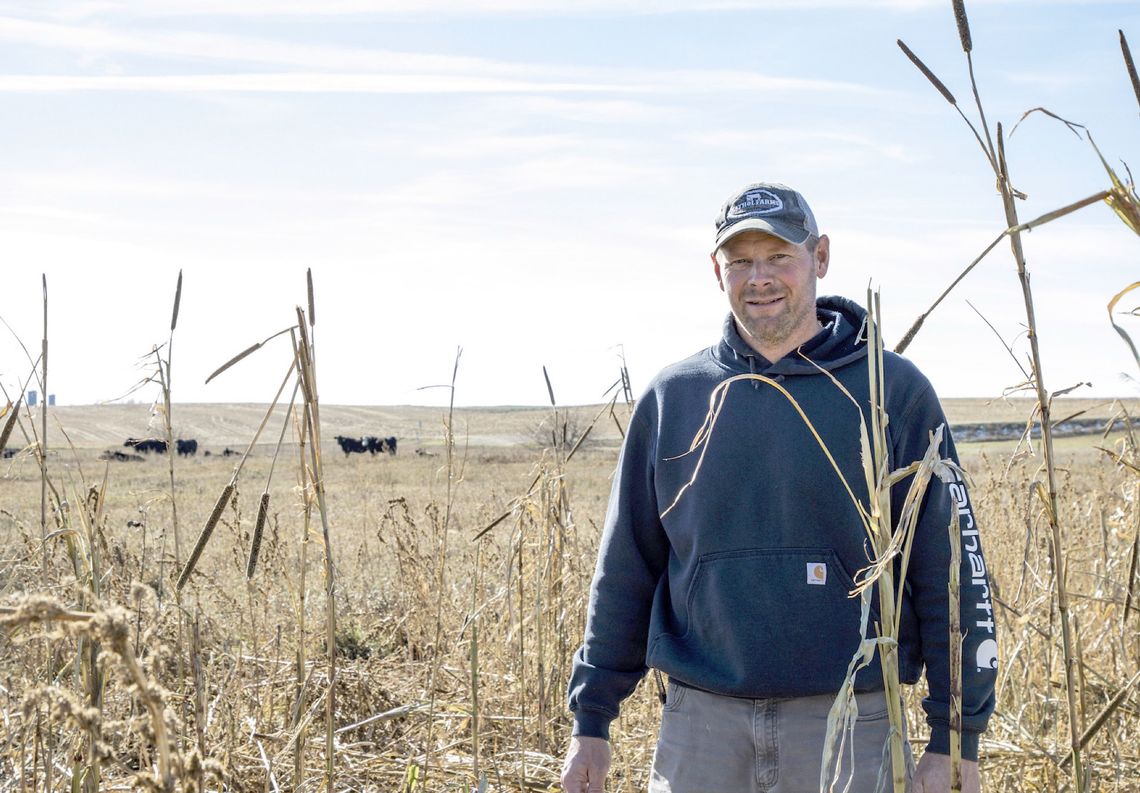HARTINGTON — Matt Kathol stepped out of the box from traditional farming practices, by emphasizing soil health, water quality, and sustainable livestock management practices working with the local USDA - Natural Resources Conservation Service.
Kathol currently manages a 300-head cattle operation with an innovative approach.
Through the NRCS’s Environmental Quality Incentives Program (EQIP) Conservation Incentive Contracts (CIC) he introduced an eightway forage crop mixture, incorporated a diverse crop rotation and multi-species cover crops.
This method helps maintain continuous living roots in the soil.
“Matt has history with no-till and cover crops in his operation,” said Rebekah Poppe, District Conservationist with NRCS in Cedar County. “He recently developed a goal of getting to the point where he could run his 300 head cattle operation on cropland acres and no longer have a need for his grassland pasture during the summer months. His overall plan was to incorporate an intense management system that includes a diverse crop rotation where he will raise cash crops (with cover crops) two years and the third year will consist of a forage crop.”
Practices like cover crops can conserve moisture and improve soil structure, offering significant benefits over traditional farming methods. Conservation practices can lead to reduced inputs and chemicals while maintaining high crop yields.
During a conversation with Becky Ravenkamp, Bow Creek Watershed Coordinator with the Lewis and Clark Natural Resources District, Ravenkamp mentioned to Kathol he may qualify for local or federal conservation programs.
He spoke with Brandon Rosberg, Soil Conservationist with NRCS, and they began planning what programs and practices would be best suited for his operation. The implementation of conservation practices has been successful, and he continues to notice improvements in livestock productivity and soil quality.
“Working with Brandon has been great,” Kathol said. “You start surrounding yourself with people that are thinking in the same direction, and it just makes you excited to try this or that. I started to really see (conservation practices) can help elevate where I'm trying to go.”
The local NRCS staff started the process by meeting with Matt at his property and discussing his idea for resource concerns and how the system would work. Before planning could take place the NRCS team conducted an infield evaluation of Matt’s property focusing on soil health and plant productivity.
A plan was developed that focused on Matts goals. An adjusted plan was needed so the old rotation could flow smoothly into a new high diversity rotation with as little burden to Matt as possible. Matt also changed some of his cash crop hybrids to allow for earlier harvesting and opting to harvest some high moisture corn to allow more time for fall panted cover crop growth before a frost.
Kathol’s conservation journey began with a desire to restore soil to its native state for the benefit of future generations. This led him to implementing no-till. He started to see the difference made in the soil structure. The compaction layers started to loosen, water infiltration rates increased, he started to see a greater rate of nutrient cycling in the soil, and yields increased. He understood the importance of including conservation in his farming practices and had the autonomy to choose which proactive and sustainable measures were implemented.
“I believe conservation is going to pay me back in a manner that a lot of people don't think is possible,” Kathol said. “I'm trying to prove a point. I think there's enough people that have been doing things like this that really shows that you can make the soil work for you.”
In addition to utilizing NRCS programs his farm is a part of the Bow Creek Watershed Project. The project is an initiative by the Lewis and Clark Natural Resources District (NRD) and other agencies to combat E. coli contamination in Bow Creek. His “out of the box” thinking contributed significantly to improving water quality in the region.
The Bow Creek Watershed spans over 392,574 acres in Cedar, Dixon, and Knox Counties. Water quality assessments by the Nebraska Department of Environment and Energy identified elevated levels of sediment, phosphorus, nitrates, and E. coli in Bow Creek. His “out of the box” and implementation of management practices will play a role in improving water quality within the Bow Creek Watershed.
To combat this the organizations have come together to emphasize the adoption of best management practices. These practices include nutrient management, cover crops, no-till management, riparian buffer strips, grazing management plans, and more.
“In an area where crop rotations are primarily corn-bean, Kathol’s operation catches your eye and perks your interests when driving by on the highway,” Poppe said. “Most importantly, he is maintaining a profitable cropping system that is improving soil health, water quality, and livestock productivity.”
The community had an opportunity to learn more and see the operation firsthand during a field day event where Kathol showcased his methods. Kathol’s advice to those who may be hesitant about embracing conservation or getting started was simple: think outside the box.
“Yes, I put the forage crops on good land that could yield really well compared to my other average farms,” Kathol said. “I’ve proven with cover crops I can raise my best corn with the same number of inputs. With this approach my inputs are down, and my chemical costs are down.”
Farmers like Matt Kathol are at the forefront of this movement, demonstrating that with innovation and dedication, agriculture can be both environmentally friendly and economically viable. NRCS helps ensure the profitability and sustainability of local agriculture by providing resources, planning and funding for conservation practices.
For more information about conservation planning and programs, visit your local NRCS office or go to ne.nrcs.usda.gov.
.jpg)











